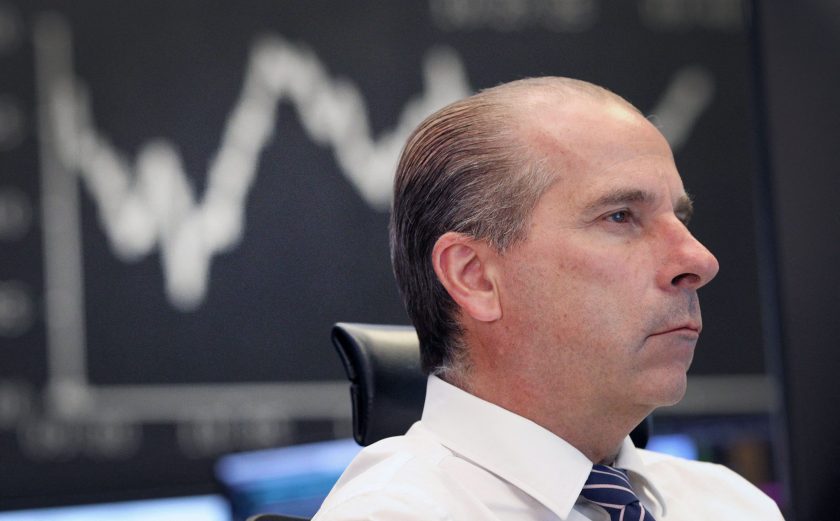
Bond traders are digesting a lot of geopolitical risks. DANIEL ROLAND/AFP via Getty Images
The surprisingly strong U.S. economy and mixed signals from the Federal Reserve have fueled some of the wildest Treasury bond swings in recent memory. Add geopolitical angst and a surge in debt supply and you have a recipe for sustained volatility in the coming months, market watchers say.
Dubbed the safest asset in the world, Treasury bonds have proven anything but recently as dramatic moves in yields have become an almost daily occurrence. Just this week, the 10-year rate fluctuated within a range of nearly 40 basis points, buffeted by cross-currents including resilient retail sales and unemployment numbers, a series of comments from Fed officials and growing demand for assets. refuge, amid concerns about an escalation of the conflict in the Middle East. East.
It’s going to be a tough ride, so buckle up, Mike Schumacher, head of macro strategy at Wells Fargo Securities, said this week on Bloomberg TV. Interest rate volatility is expected to remain quite high, at least until the middle of next year, perhaps even more so as the Middle East recovers and until the market has more clarity about the Fed.
The ICE BofA MOVE index, which tracks expected swings in Treasury yields priced in one-month options, has risen for five consecutive weeks. In fact, for one thing, swings in long-term rates exceed those in stocks by the most in at least 18 years, according to data compiled by Bloomberg.
This is partly because the Fed is struggling to signal a long-term view on where interest rate policy is headed, according to Mohamed El-Erian, chief economic advisor at Allianz SE and columnist for Bloomberg Opinion.
We will remain in this situation of great uncertainty because there is no vision about the direction this economy is taking, El-Erian said on Bloomberg TV on Friday. They need to move from excessive data dependence to data dependence that has a more forward-looking component.
Amid the tumult of recent weeks, nothing caused more chaos than Fed Chairman Jerome Powell’s comments on Thursday about the path of monetary policy. He suggested at an event at the New York Economic Club that the U.S. central bank is inclined to hold interest rates steady at its next meeting, leaving open the possibility of another increase later if policymakers see more signs of resilient economic growth.
In response, the rate curve steepened aggressively, with short-term yields falling while longer-term yields rose to new multi-year highs.
Geopolitics, Supply
Last week’s price swings were also fueled by growing concerns that the war between Israel and Hamas could spread across the region, potentially drawing even the US.
Reports of drone strikes in Iraq and Syria, cruise missiles fired at Israel by Houthi rebels in Yemen, and Israeli strikes against Hamas and Hezbollah have led to a reactionary bid for security among investors, sending yields 10 years fell from their highs just below 5% and ended the week at around 4.91%
Concerns about the US fiscal future are also increasingly affecting investor sentiment.
Rising U.S. debt issuance has helped increase the so-called term premium by more than a percentage point over the past three months, fueling a dramatic rise in long-term rates. Traders are already preparing for the Treasury to announce further increases in auction sizes in its next quarterly reimbursement on November 1.
Volatility is breeding more volatility, said William Marshall, head of U.S. rates strategy at BNP Paribas SA. There is just a general lack of strong conviction at this stage about where things should be anchored.
What Bloomberg strategists say
It is difficult to see what would lead to a significant and sustained recovery in bonds without a US recession. A recession depends on the services part of the economy, where the outlook is balanced.
Simon White, macro strategist
For the full note, click here
Looking ahead, a pause in Fed trading next week due to central banks’ usual blackout period ahead of the Nov. 1 monetary policy meeting could be a welcome relief for traders.
Still, the next few days will provide some key readings on price pressures in the economy, including Friday’s data on personal consumption expenditures, the Fed’s preferred measure of inflation. The University of Michigan’s Inflation Expectations Survey will be released on the same day.
#Economists #Geopolitical #economic #uncertainty #shakes #Treasury #bond #market
Image Source : fortune.com
